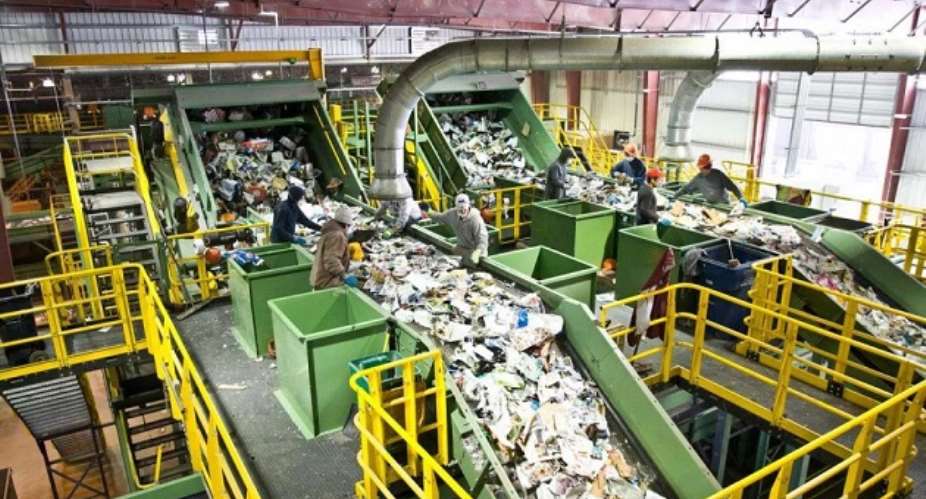What we know is Africa has a long way to achieve success in a proper way of waste disposal and recycling. Malaria is still the number one killer in Africa because of poor waste disposal and drainage systems.
Europe, America and other continents have embraced the right ways of waste disposal but Africa is still far from achieving success in genuine waste disposal and recycling procedures.
Every year billions of tons of garbage are thrown away, which can be reused or burned to generate heat. Although garbage is a useful source of recyclables and energy, its collection is expensive, given the manual labor involved.
In developed countries, household garbage and industrial waste are usually collected in bags or tanks, which are disposed of once a week by garbage trucks. In some places, there is a pneumatic system for the disposal of household waste directly through pipes leading to a local waste treatment plant.
Another method involves the accumulation of household waste in the underground bunker, located under each building, from where they are periodically removed by a tank truck with a pump. Sorting materials for recycling are costly, therefore the residents themselves are encouraged to do this work.
In some areas, local authorities ask citizens to bundle and put waste paper in bales, and in crowded places, there are special containers for empty bottles. The glass is transported to a glass factory, where it is crushed and goes to the manufacture of new glass products.
Additional cost savings are provided by installing separate containers for products made from brown, green and colorless glass, which simplifies their sorting at glass factories.
Some drinks are sold in bottles, for which a small deposit is charged, refundable upon delivery of empty containers. This encourages customers to return empty glass containers, which the manufacturer then takes from stores for reuse. Thus, significant savings in production are achieved, but there are additional costs associated with the collection, cleaning, and sterilization of waste.
Waste such as large metal products may be of interest to the local scrap metal buyer, and the owner will receive money for the most chain of them, for example, lead pipes. A number of industries produce large quantities of waste, which are either transported directly to enterprises using them in their production or recycled.
The slag, which is a waste of the coal industry, is used in construction as a material for foundations, and high-quality paper can be obtained from a certain type of rag scrap. or recycled.
Years ago, sewer systems were primitive and the stench from the garbage heaps became unbearable. Residents, therefore, burned everything and the rest of the garbage is taken to the landfill. Thanks to the amazing discovery of technology which has advanced to change the world in everything including the right disposal and recycling of waste materials.
Two main methods are used to reduce waste: chopping and incineration. Grinding is a mechanical process of crushing and cutting waste. Separate grinding machines can process up to 70 tons of garbage per hour. Combustion in a special installation at a temperature of 750-1000 "C is the most effective way to reduce the volume of garbage.
The main disadvantage of burning is the formation of significant amounts of soot and smoke. Therefore, it is necessary to apply various methods for cleaning exhaust gases from incinerators to minimize air pollution.
A large amount of waste paper, metals, plastics, and glass is used for recycling. Much of these materials are collected separately in residential and industrial areas. But in the usual garbage contains valuable materials that can be removed at different stages of processing prior to disposal.
Dried wastes are subjected to airless heating to produce a number of useful substances, including carbon monoxide, methane, charcoal hydrogen, various oils, and tar. The powerful magnets installed above the conveyor remove metals from the garbage. Different methods are used to separate glass, aluminum and other non-ferrous metals, depending on their physical properties.
Many sorting machines separate materials according to their density. For example, in an inclined plate separator, denser materials of the crushed waste slide into the bottom of the vertical conveyor, and materials of lower density are transported to the top.
Ghana has plenty of lands and vast territories suitable for building a recycling plant but this hasn't been an urgent concern to any politician. No one can develop our countries, it's our responsibility to build a healthy and happy nation.





 Meta releases new version of conversational AI across its platforms
Meta releases new version of conversational AI across its platforms
 Cape Town named Africa’s Best Airport 2024 by Skytrax
Cape Town named Africa’s Best Airport 2024 by Skytrax
 Bono East: Four injured after hearse transporting corpse crashes into a truck
Bono East: Four injured after hearse transporting corpse crashes into a truck
 ‘Be courageous, find your voice to defend our democracy’ — Sam Jonah urges journ...
‘Be courageous, find your voice to defend our democracy’ — Sam Jonah urges journ...
 Exodus of doctors, nurses and teachers have worsened because of unserious Akufo-...
Exodus of doctors, nurses and teachers have worsened because of unserious Akufo-...
 2024 election: Avoid insults, cutting down people in search of power – National ...
2024 election: Avoid insults, cutting down people in search of power – National ...
 ‘You passed through the back door but congratulations’ — Atubiga on Prof Jane Na...
‘You passed through the back door but congratulations’ — Atubiga on Prof Jane Na...
 Government’s $21.1 billion added to the stock of public debt has been spent judi...
Government’s $21.1 billion added to the stock of public debt has been spent judi...
 Akufo-Addo will soon relocate Mahama’s Ridge Hospital to Kumasi for recommission...
Akufo-Addo will soon relocate Mahama’s Ridge Hospital to Kumasi for recommission...
 We must not compromise on our defence of national interest; this is the time to ...
We must not compromise on our defence of national interest; this is the time to ...
